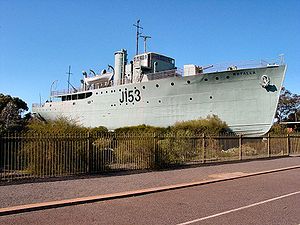HMAS Whyalla (J153)

HMAS Whyalla
|
|
| History | |
|---|---|
|
|
|
| Namesake: | City of Whyalla, South Australia |
| Builder: | Broken Hill Pty Co Ltd in Whyalla, South Australia |
| Laid down: | 24 July 1940 |
| Launched: | 12 May 1941 |
| Commissioned: | 8 January 1942 |
| Decommissioned: | 16 May 1946 |
| Honours and awards: |
|
| Fate: | Sold into civilian service |
| History | |
| Victorian Public Works Department | |
| Name: | Rip |
| Acquired: | 10 February 1947 |
| In service: | 1947 |
| Out of service: | 1984 |
| Reclassified: | Lighthouse maintenance vessel |
| Fate: | Sold in 1984 |
| History | |
| Whyalla City Council | |
| Name: | Whyalla |
| Acquired: | Late 1984 |
| Status: | Landlocked museum ship |
| General characteristics during RAN service | |
| Class and type: | Bathurst-class corvette |
| Displacement: | 733 tons (standard) |
| Length: | 186 ft (57 m) |
| Beam: | 31 ft (9.4 m) |
| Draught: | 8.5 ft (2.6 m) |
| Propulsion: | triple expansion engine, 2 shafts |
| Speed: | 15 knots (28 km/h; 17 mph) at 1,750 hp |
| Complement: | 85 |
| Armament: |
|
HMAS Whyalla (J153/B252), named for the city of Whyalla, South Australia was one of 60 Bathurst-class corvettes constructed during World War II and one of 20 built on Admiralty order but manned by personnel of and later commissioned into the Royal Australian Navy (RAN). The ship was sold to the Victorian Public Works Department at the end of the war, who renamed her Rip and used her as a maintenance ship. In 1984, she was purchased by Whyalla City Council, who put her on display as a landlocked museum ship in 1987.
In 1938, the Australian Commonwealth Naval Board (ACNB) identified the need for a general purpose 'local defence vessel' capable of both anti-submarine and mine-warfare duties, while easy to construct and operate. The vessel was initially envisaged as having a displacement of approximately 500 tons, a speed of at least 10 knots (19 km/h; 12 mph), and a range of 2,000 nautical miles (3,700 km; 2,300 mi) The opportunity to build a prototype in the place of a cancelled Bar-class boom defence vessel saw the proposed design increased to a 680-ton vessel, with a 15.5 knots (28.7 km/h; 17.8 mph) top speed, and a range of 2,850 nautical miles (5,280 km; 3,280 mi), armed with a 4-inch gun, equipped with asdic, and able to fitted with either depth charges or minesweeping equipment depending on the planned operations: although closer in size to a sloop than a local defence vessel, the resulting increased capabilities were accepted due to advantages over British-designed mine warfare and anti-submarine vessels. Construction of the prototype HMAS Kangaroo did not go ahead, but the plans were retained.
The need for locally built 'all-rounder' vessels at the start of World War II saw the "Australian Minesweepers" (designated as such to hide their anti-submarine capability, but popularly referred to as "corvettes") approved in September 1939, with 60 constructed during the course of the war: 36 ordered by the RAN, 20 (including Whyalla) ordered by the British Admiralty but manned and commissioned as RAN vessels, and 4 for the Royal Indian Navy.
...
Wikipedia
